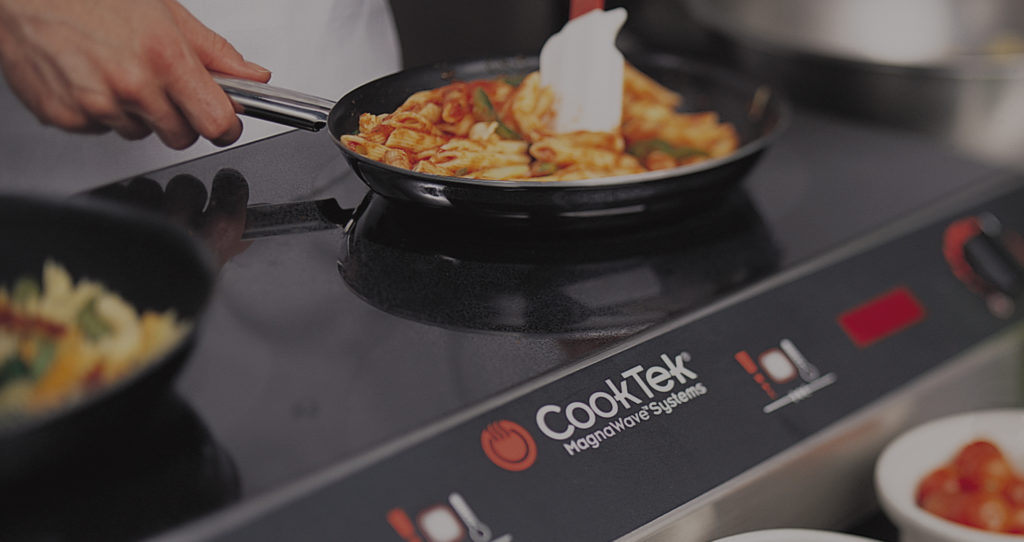Blog Post: Exploring Induction Cooking in Commercial Kitchens
Induction cooking is a modern method that utilizes electromagnetic fields to generate heat directly in the cookware. Unlike traditional gas or electric cooking methods that transfer heat from a burner to the pot, induction cooktops use magnetic energy to heat the cookware. This fast, energy-efficient method offers precise temperature control, making it an increasingly popular choice in residential and commercial kitchens.
How Does Induction Cooking Work?
.png?width=584&height=352&name=What-Is-Induction-Cooking-Definition-Pros-Cons-More%20(1).png)
Induction cooking involves an induction coil beneath the cooktop's surface. When the cooktop is turned on, an alternating electric current passes through the coil, creating an oscillating magnetic field. This magnetic field induces an electric current in the ferrous (magnetic) cookware placed on the cooktop, causing it to heat up.
The key here is that the heat is generated directly in the cookware rather than the cooktop, which remains cool to the touch. This not only improves safety in the kitchen but also increases energy efficiency since no heat is wasted.
Benefits of Induction Cooking in a Commercial Kitchen
-
Energy Efficiency: Induction cooking is highly energy-efficient, with up to 90% of the energy generated being used to heat the cookware. This is significantly higher than gas (about 40%) and electric (about 70%) stoves.
-
Speed and Precision: Induction cooktops instantly heat cookware, reducing cooking times. The precise temperature control allows chefs to make quick adjustments, ensuring consistent results.
-
Safety: Since the cooktop doesn’t get hot, the risk of burns is reduced, and there’s no open flame, lowering the risk of fire hazards in a busy commercial kitchen.
-
Easy Cleaning: Spills don’t burn onto the cooktop surface since they remain relatively cool, making cleanup much easier and faster.
-
Improved Kitchen Environment: Induction cooking produces less ambient heat than gas and electric methods, helping maintain a cooler and more comfortable kitchen environment, which is crucial in a high-pressure commercial setting.
Integrating Induction Cooking in a Commercial Kitchen
Induction cooking is an excellent choice for commercial kitchens that need to balance speed, efficiency, and precision. Whether it’s a small bistro or a large-scale restaurant, induction cooktops can be seamlessly integrated into the kitchen layout. They are particularly beneficial in open kitchen designs where visual appeal and a clean environment are essential.
Cooking Equipment Comparison
Read below to learn more about the difference between induction cookware and other popular cooking methods commonly used in restaurants.
Induction Vs. Gas
A gas range is heated using various gas sources, including natural gas, propane, and butane. It is one of the most common types of cooking equipment in commercial kitchens. While induction stovetops require electricity to power them, gas cooktops are powered by gas and, therefore, require no electricity. This makes gas ideal for remote locations, outdoor catered events, and kitchens looking to lower their electric usage.
Additionally, gas cooktops feature a flame that can instantly be made lower or higher with the turn of a dial. This control over the flame can provide a more instantaneous effect on the heat level than the adjustments on induction cooktops. A 3500-watt induction unit is equivalent to a 35,000 BTU gas burner without any of the cons.
Here are a few cons to using a gas cooktop:
- Potential for gas leaks if used or installed improperly
- It won’t get as hot as an induction cooktop
Induction Vs. Electric
An electric stovetop uses electricity to heat coiled elements or a ceramic radiant surface. It is typically less expensive and less hassle to install than induction or gas cooktops and requires very little maintenance. Unlike induction cooking, gas and electric stovetops can be used with any cookware.
Electric cooktops are more energy-efficient than gas in terms of how much heat reaches the food, but they still fall short of the 90% energy efficiency seen by induction cooktops. Electric cooktops generally require less upfront cost and no specialized cookware but are less responsive to temperature control.
Here are a few cons to using an electric cooktop:
- The surface gets very hot
- There’s a slow change in heat, which means less control over the temperature than gas or induction
- Won’t heat food as hot as gas or induction
- You cannot allow the surface plates to idle unloaded (you need to have a pot with water in them on med-lo or risk damaging the plates)
CookTek Induction Cooking Solutions
For those considering induction cooking, CookTek offers a range of commercial-grade induction cooktops that are durable, efficient, and designed specifically for the demands of a busy kitchen. CookTek products are known for their reliability and advanced features that help chefs maintain control over the cooking process.
Check out CookTek’s Induction Cooktops for more details on their available options.
Cookteck offers more than just induction ranges; there are planchas, soup kettles, wok ranges, and meal delivery options that all offer the benefits of induction cooking.
Conclusion
Induction cooking is not just a trend but a practical and innovative solution for modern commercial kitchens. Its energy efficiency, safety, speed, and ease of use benefits make it a worthy investment for any food service operation looking to optimize performance and enhance the culinary experience.
Contact Griffin Commercial Kitchen today for more information on how induction cooking can transform your kitchen and to explore CookTek’s offerings.





Leave a Reply